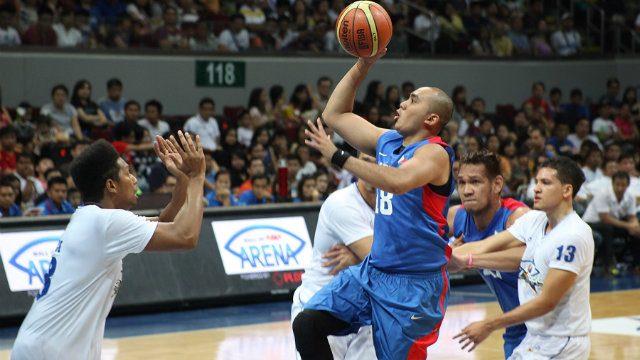SUMMARY
This is AI generated summarization, which may have errors. For context, always refer to the full article.

For all intents and purposes, our third place finish in the 2014 FIBA Asia Cup in Wuhan, China was a historic accomplishment. It was the first time a Philippine team finished on the podium in the biennial event, after all. We finished with a 5-1 record, losing only to eventual champions Iran in the semifinals. We swept the group stage, beating Taiwan, Singapore, and Jordan, defeated India in the quarterfinals, and then pulled the rug from under the Chinese in the dying seconds of the battle for third.
It was definitely a memorable ride for Gilas, and a fitting send-off (I’m not counting the Last Home Stand farce as a send-off) as the team embarks on a momentous trek to the 2014 FIBA World Cup in Spain.
That’s not to say everything was fine and dandy, of course. In each of our wins, even against historical minnows like Singapore and India, we had to grind it out. We generally leaned on fourth quarter runs to get each of our victories, and the team was definitely far from the form it flashed in the 2013 FIBA Asia tournament. This isn’t entirely unexpected, since the team missed a handful of key players and some guys were fresh from the 2014 Governors’ Cup Finals. Conditions were definitely far from ideal, but that didn’t make it easier to watch Gilas commit turnovers and brick its shots on several occasions.
Upon reflecting on Gilas’s campaign, I came up with the following points — things we learned from the tournament and can, hopefully, address or keep in mind moving forward. All these, of course, are for the continued improvement of Philippine hoops.
This part one of a two part series.
Paul Lee is perfect for Gilas
Or, at least, he’s perfect for the system of the current iteration of Gilas. If he were playing for Rajko Toroman in 2011, maybe he wouldn’t be as effective as he was for coach Chot Reyes in the FIBA Asia Cup. Who knows? The reality is that, without Lee, it would be hard to imagine Gilas finishing among the top three in Wuhan. He led the team in scoring in the Pinoys’ first four games. He hit the third-place-clinching free throws against China. He was the guy most willing to take matters in his own hands when push came to shove.
The former UE Red Warrior and current Elasto Painter averaged about 12 points, 2 rebounds, and 2 assists in China while also leading all players with a 50% success rate from beyond the arc. He broke down defenders countless times with his sublime ball handling while also dropping key three pointers. For a team like Gilas, which has very minimal ceiling and relies heavily on speed and shooting and the dribble-drive system, Lee is a prime fit.
Clearly, this is a guy we will need in Spain and beyond.
Our PBA MVP is still a FIBA Asia scrub
In the PBA, June Mar Fajardo averaged around 17 points, 14 rebounds, and 2 blocks while shooting 55% from the field this past season. Those stats were enough to earn for him Best Player of the Conference honors in the Philippine Cup and, eventually, his first ever Most Valuable Player award. At just 24 years of age and only in his sophomore campaign in the PBA, his achievements are nothing short of amazing.
So what the hell happened to our MVP, the Kraken, when he put his Pilipinas kit on and took to the hardwood against some of Asia’s most promising big men?
He was a flop. A scrub. An underwhelming shell of the man-child who wreaked havoc in the local pro circuit.
Fajardo’s averages in the FIBA Asia Cup? About 2 points and 2 rebounds while shooting 27% from the floor in around 11 minutes per outing. His best game was dropping 5 points and 6 rebounds against Singapore. It’s worth noting that he was the only Gilas player who didn’t play against China.
In contrast, other young big guys who are not MVPs of their own leagues, most of whom are substitute centers, tallied the following stats against Gilas and June Mar:
– Lee Te-Wei (6-foot-7, 23-year old from Taiwan): 3 points, 3 rebounds, and 1 block.
– Delvin Goh (6-foot-7, 19-year-old from Singapore): 9 points, 7 rebounds, 2 steals, and 2 blocks.
– Mohammad Shaher Hussein (6-foot-11, 24-year-old from Jordan): 7 points and 9 rebounds.
– Ahmad Al-Dwairi (6-foot-11, 21-year-old from Jordan): 13 points, 14 rebounds, 1 steal, and 2 blocks.
– Amritpal Singh (6-foot-11, 23-year-old from India): 20 points and 10 rebounds.
– Arman Zangeneh (6-foot-8, 21-year-old from Iran): 5 points and 3 rebounds.
These are guys whom Fajardo (and probably Greg Slaughter) will have to face on a constant basis in the next few years. Suffice to say that, based solely on these results, the Kraken will have it tough. I guess it’s a good thing, then, that Andray Blatche still has a lot left in the tank to shore up our center spot.
It was painful watching Fajardo struggle in the 2013 FIBA Asia tourney, often coming in only as a third-string center when the game was beyond doubt. It was even more painful this time around, however, because it’s no longer his first foray into FIBA Asia hoops, and his being PBA MVP should have boosted his confidence that much more.
But no. Right now, it’s crystal clear that Fajardo still has a long way to go to be counted in the conversation of Asia’s best slotmen. – Rappler.com
Add a comment
How does this make you feel?
There are no comments yet. Add your comment to start the conversation.